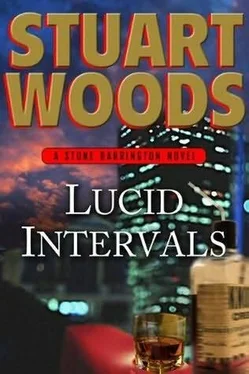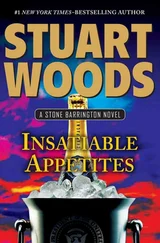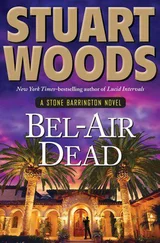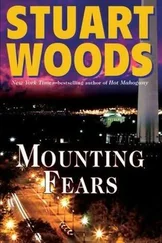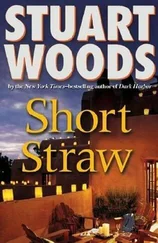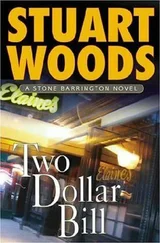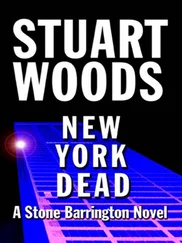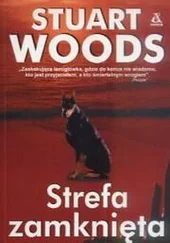A man in coveralls stood by the door of the airplane. “Your preflight inspection is all done, Mr. Hackett,” the man said. “The ground power unit is connected, and the air-conditioning is on.” He opened the door and let down a set of steps. “I’ve entered your clearance into the onboard flight plan.”
“Hop in,” Hackett said to Stone. “Take the left seat.”
“I’ve never flown a jet,” Stone protested.
“Then it’s about time you did,” Hackett said, pushing him aboard.
Stone got into the left seat and found three large glass displays lit up.
“I’ll do the radios and the avionics,” Hackett said, putting on a headset and indicating that Stone should do likewise. “You just fly the airplane.”
Stone picked up the light headset hanging on the yoke before him and put it on.
Hackett was already on the radio, requesting permission to taxi. “Okay,” he said to Stone, “release the parking brake there, do a one-eighty turn and follow the taxi line around to the left.”
Stone adjusted his seat and then did as instructed. They stopped at the threshold for runway 1 and were told to wait for final clearance.
“Watch,” Hackett said. He pressed a button on one of the throttles, and a set of command bars popped up. He flipped up a switch on the panel. “Pitot heat on,” he said. “Now on clearance, taxi onto the runway and stop. Press the heading button and the switch above it, there.” He pointed. “We’ve been given the Teterboro Five departure. That means we fly heading 040 after takeoff and at fifteen hundred feet turn left toward Patterson VOR and climb to two thousand feet.” He turned a knob on the autopilot, and “2,000 feet” appeared in a little window on the primary flight display. They were cleared for takeoff, and Stone taxied onto the runway and stopped.
“Hold the brakes and push the throttles all the way forward,” Hackett said.
Stone did so, and the engines came to a roar.
“Release the brakes, and I’ll call the speeds for you,” Hackett said.
Stone released the brakes, and the airplane leapt down the runway.
“Airspeed’s alive,” Hackett said. “Seventy knots, V1. Put both hands on the yoke and… rotate. Keep the flight director at the command bars.”
Stone rotated and watched the screen, then did as he was told.
“Seven hundred feet, autopilot on,” Hackett said, “heading 040. Fifteen hundred feet, turning left.” He turned the heading knob, and the airplane followed its instructions. “Two thousand feet, leveling off, reducing power,” Hackett said. “Pull the throttles back to sixty percent.” He tapped a gauge.
Air traffic control came on and gave them 6,000 feet and direct Brezy, which Stone knew from his own experience was an intersection near the Carmel VOR.
“Where are we going?” he asked.
“Fly the airplane and don’t ask questions,” Hackett said, dialing in the new direction and altitude. Soon they were over Connecticut and handed off to Boston Center. They were given 35,000 feet for a new altitude, and Hackett made the control changes. “The autopilot has the airplane,” he said to Stone. “Now you can talk.”
“Where are we going?” Stone asked.
“To Bar Harbor, Maine,” Hackett replied. “We’ll find Whitestone near there.”
The airplane climbed to 35,000 feet and leveled off. “This is awfully easy to fly,” Stone said.
“It is, once you’ve been trained. You already know how to fly; learning to operate the new avionics and handle emergencies is the hard part.” Hackett began giving Stone a lesson in using the switches and displays. The logic was much the same as that on Stone’s airplane, since the avionics manufacturer of both was Garmin. Shortly, they were given direct Bar Harbor, and Hackett showed him how to accomplish that.
“There’s nothing else to do but monitor the gauges until we descend.” An hour later they were descending into Bar Harbor Airport in gloriously clear weather. Hackett talked Stone through the landing, and shortly they were at the ramp.
Stone followed Hackett to the parking lot, where another of his black SUVs was waiting, but this time Hackett drove. They crossed a short bridge onto Mount Desert Island and, ignoring the turn for Bar Harbor, drove toward the village of Somersville.
Once in the tiny eighteenth-century clapboard village, Hackett drove past a church and then pulled over. “Follow me,” he said, getting out of the car.
They walked along a well-tended path through a cemetery, and Hackett stopped and looked around. “Would you say we are alone?” he asked.
Stone looked around. They were out of sight of the road now. “I’d say we are,” he replied.
“Let’s keep going, then.” Hackett strode off with Stone behind him trying to keep up. Then Hackett abruptly stopped.
“STONE,” HE SAID, “may I present Mr. Stanley Whitestone, late of London, England, but resident in this country for some years.”
Stone looked down and saw the granite headstone with Whitestone’s name and dates on it.
“I buried him nearly two years ago,” Hackett said.
They returned to the car, and Hackett drove on for another mile. Then he turned left onto a paved road that became gravel, continued to the end and through a gate and stopped in front of a shingle-style house. They got out of the car and entered through the front door, which was not locked.
“This way to my study,” Hackett said.
Stone followed him down a hallway and into a large, paneled room filled with books, with a computer desk built into one corner.
Hackett began rummaging through filing cabinets, muttering to himself. “I know they’re here somewhere,” he said. Finally, he extracted an envelope. “Have a seat and inspect these,” he said, pointing to a chair before the fireplace. He switched on a lamp so that Stone could see better.
Stone opened the envelope and extracted some eight-by-ten color photographs. A naked man lay on a gurney with a cloth laid over his crotch. His chest was badly bruised, and there was a cut on his chin. He looked very much like an older version of the Stanley Whitestone photograph Felicity had given him.
Hackett sat down on the sofa next to Stone’s chair. “Whitestone was my guest up here two years ago. I loaned him a car so that he could see some of the island. We had a dinner reservation, and when he had been gone for several hours I called the police to report him missing. I was passed on to an officer who asked me to describe Stan and the car he was driving. I did so, and he told me that Stan had been badly injured in a head-on collision with a fully loaded dump truck, a few miles from here.
“I went to the Bar Harbor Hospital and found that he had died only a moment before my arrival. I took those photos with a pocket camera I occasionally carry.”
Hackett sighed. “I knew that he wasn’t married and that his parents were dead. There were no siblings, either, so there was no one I knew of to inform. Finally, after the body had been in the hospital morgue for a couple of days, I called Lord Wight, who had recommended that I interview him for an open position in my firm, and he couldn’t help, either. He did tell me that the man, who I had been told was named Robert Foster, was Stanley Whitestone. I had heard something of him on the grapevine. I made arrangements with the local funeral directors and bought a plot in the churchyard. Apart from the funeral director, I was the only person at the burial. There’s another envelope inside the envelope in your hand.”
Stone extracted a smaller envelope, opened it and found a death certificate. “Had you ever met him before he came to see you?”
“No, he called from New York and flew commercial up here, and I put him in the guesthouse. We talked for a while over lunch the following day, and I was impressed and had about decided to offer him the job. Then he went sightseeing, and I didn’t see him again until he was dead.”
Читать дальше
